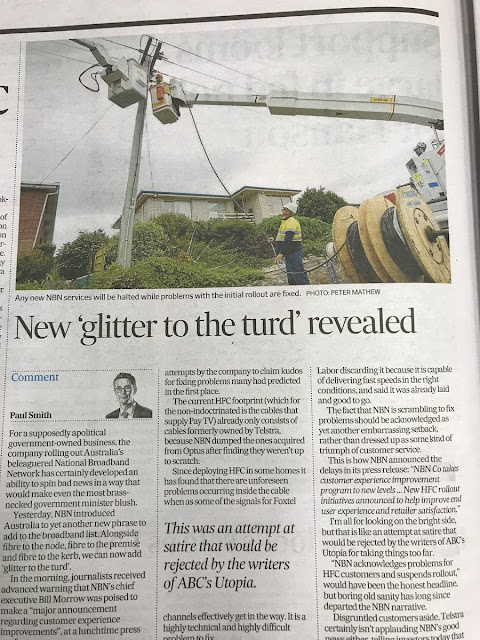On Tuesday 17 April the Telecommunication Industry Ombudsman (TIO) sent out the media
release in this post.
It looks suspiciously like the Minister is now approaching a scheduled review of telecommunications consumer protections and the complaints process with a view to quash an inconvenient truth – that transfers to the version of the National
Broadband Network (NBN) cobbled together by Tony Abbott and MalcolmTurnbull are a dismal failure for far too many Australian businesses and households.
Telecommunication
Industry Ombudsman (TIO), media
release, 17 April 2018:
Report highlights
increase in complaints about landline, mobile and internet services
Australian residential
consumers and small businesses made 84,914 complaints to the Telecommunications
Industry Ombudsman in the last six months of 2017 (1 July 2017 to 31 December
2017). In this period, complaints about landline, mobile and internet services,
increased by 28.7 per cent compared to the same six month period in 2016.
Publishing the
Telecommunications Industry Ombudsman’s Six Monthly Update today (Tuesday 17
April, 2018), Ombudsman Judi Jones said “The telecommunications industry in
Australia continues to experience significant change. An increasing range of
products and services are being offered to consumers, expectations for the
quality of phone and internet services are high, and the rollout of the
National Broadband Network is changing the way we use telecommunications
services.
“However, consumers
still seem to be facing the same problems, particularly with their bills and
the customer service they receive. Confidence in services being updated or
transferred reliably, faulty equipment, and poor service quality were also
recorded as key issues. Additionally, the wider issues relating to phone or
internet problems such as debt management are concerning.”
Jones added, “Complaints
about services delivered over the National Broadband Network continued to
increase compared to the same six month period in 2016. This indicates the
consumer experience is still not meeting expectations for all. Recent changes
to regulation and an increase in our powers to resolve complaints are positive
steps that will help improve the consumer experience.”
Highlights for the
period 1 July 2017 to 31 December 2017 include:
* 84,914 total
complaints were received
* 74,729 complaints (88
per cent) were from residential consumers
* 9,947 complaints (11.7
per cent) were from small businesses
Landline, mobile,
internet, multiple services and property
Complaints for the
period increased 28.7 per cent compared to the same six month period in 2016.
* 9,447 complaints (11.1
per cent) were recorded about landline phone services
* 24,923 complaints
(29.4 per cent) were recorded about mobile phone services
* 23,785 complaints (28
per cent) were recorded about internet services
* 26,112 complaints
(30.8 per cent) were recorded about multiple services*
* 647 complaints (0.8
per cent) were recorded about property*
* Charges and fees,
unsatisfactory response from the provider (provider response), and poor service
quality were the most common issues.
Small Businesses
Between 1 July and 31
December 2017 complaints from small businesses increased 15.6 per cent to 9,947
compared to the same period in 2016.
* Complaints from Small
Businesses accounted for 11.7 per cent of total complaints for the period
* 2,178 complaints (21.9
per cent) were recorded about landline phone services
* 2,074 complaints (20.9
per cent) were recorded about mobile phone services
* 1,716 complaints (17.3
per cent) were recorded about internet services
* 3,937 complaints (39.6
per cent) were recorded about multiple services*
* 42 complaints (0.4 per
cent) were recorded about property
* The
main issues affecting small businesses were charges and fees, unsatisfactory
response from the provider (provider response), and no service.
Complaints by State
All states and territories
in Australia saw a growth in complaints in the last six months of 2017 compared
to the same period in 2016.
Queensland recorded the
highest growth in complaints, an increase of 39.3 per cent, followed by Western
Australia with 36.5 per cent.
Complaints by state (in
alphabetical order) are as follows:
* Australian Capital
Territory made 1,184 complaints, an increase of 11 per cent
* New South Wales made
26,914 complaints, an increase of 27.9 per cent
* Northern Territory
made 504 complaints, an increase of 20 per cent
* Queensland made 16,418
complaints, an increase of 39.3 per cent
* South Australia made
6,552 complaints, an increase of 22.7 per cent
* Tasmania made 1,614
complaints, an increase of 33.1 per cent
* Victoria made 23,954
complaints, an increase of 30.5 per cent
* Western Australia made
7,381 complaints, an increase of 36.5 per cent
* The main issues
affecting Australian states and territories were charges and fees,
unsatisfactory response from the provider (provider response), and poor service
quality
Services delivered over
the National Broadband Network
Complaints about
services delivered over the National Broadband Network increased 203.9 per cent
to 22,827 on the same period in 2016.
* 14,055 complaints were
recorded about service quality
* 8,757 complaints were
recorded about delays in establishing a connection
* The
main issues affecting residential consumers and small businesses were
unsatisfactory response from the provider (provider response), poor service
quality, and connecting a service (connection/changing provider)
NOTES TO EDITORS
*From 1 July 2017, the
Telecommunications Industry Ombudsman changed the recording of complaints.
There are now five complaint service categories: landline phone services,
mobile phone services, internet services, multiple services (where the consumer
is complaining about more than one phone or internet issue), or a complaint
about damage or access to property. The changes mean data will more accurately
reflect the description of complaints given by residential consumers and small
businesses. The changes also make it easier to see the issues facing
the telecommunication industry, helping providers improve the delivery of phone
and internet services. Trend analysis will build over time from the start of
this reporting period.










